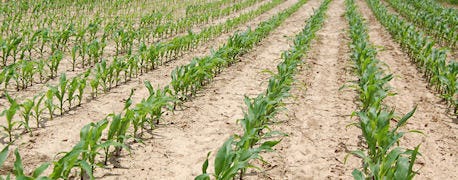June 23, 2013

May-planted corn is up and growing.
However, uneven plant sizes and purple and yellow plants have many growers nervous about reduced yields, says University of Illinois crop sciences professor Emerson Nafziger.

U of I's Nafziger Says "Purple" Corn Should Self-Correct
"We often see purple corn when soils are cool and dry during early plant growth stages, or much more rarely in fields with low soil test phosphorus levels," Nafziger says. "The purple color is from a pigment that forms when there is more sugar in the leaves than the plant can utilize. Low phosphorus inhibits sugar movement out of leaves, and cool, dry soils reduce root growth and sugar movement to the roots. Both of these can increase sugars in the plant and make the tissue turn purple."
Soils are not cool and dry in Illinois now, but surface soils are drying out in many fields. Root growth has probably been restricted some by soils that were too wet as well as compacted by tillage and planting operations in some cases.
"In fields where the plants have taken up enough nitrogen and water to grow well, but where roots remain constricted, purpling might be common—especially in those hybrids that have a tendency to form the purple pigment," he says.
Growers can expect the problem of purple corn to correct itself as root growth continues.
"It will help if wet soils continue to dry out, but in fields with dry surface soils, root growth might benefit from some rainfall," Nafziger adds. "There is no evidence that temporary purpling affects yield of the crop, though factors such as soil compaction that can lead to purpling might also reduce yields if the weather is dry later in the season."
Other fields are showing the yellow color that characterizes nitrogen deficiency. Seeing patterns such as nitrogen applicator knife tracks where the plants are greener helps to confirm this as the problem.
~~~PAGE_BREAK_HERE~~~
"As is the case with purpling, we tend to see more yellow plants in the lower areas of the field," he notes. "This is where soils were wetter at planting time, are now more compacted, and where we would expect more problems with nitrogen loss and poor root growth."
Some producers have already responded to yellow plants by applying a higher rate of sidedress nitrogen than had been planned, or by applying sidedress nitrogen on top of the full rate of nitrogen that was previously applied.
"If soils are still wet in such fields and plants are continuing to struggle with poor root growth and poor root function, adding nitrogen may have little immediate effect," he says. "We haven't found evidence of much loss of nitrogen from fertilizer applied earlier in the spring."
As soils dry out and temperatures stay warm, Nafziger says it is likely that many fields with yellow corn plants will improve rapidly.
"Late planting and warm temperatures tend to favor top growth over root growth, but we expect that as leaves grow and start to improve in color, and soil oxygen levels increase as soils dry, sugars will become more available to the roots, as well as the tops," he adds. "This will improve both root growth and the ability of roots to take up nutrients."
In the unlikely event that crop color remains poor even after a week of drying soils and good growing conditions, it is possible that nitrogen movement to below the rooting depth is affecting the ability of the crop to grow out of this problem. In that case, Nafziger said a small "primer" shot of nitrogen might help the crop revive and grow roots faster in order to reach nutrients more quickly.
Source: University of Illinois
You May Also Like




